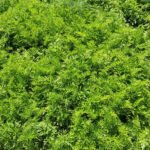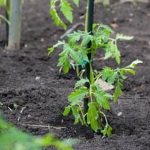Pine needle mulch in vegetable gardens is a popular and effective way to promote healthy plant growth. This natural, sustainable option provides numerous benefits for gardeners looking to maintain their vegetable plots. From preventing weed growth to improving soil moisture retention, the use of pine needle mulch presents a variety of advantages that make it a valuable addition to any garden.
Pine needle mulch offers several key benefits that set it apart from other types of mulches. In this article, we will explore the unique advantages of using pine needle mulch in vegetable gardens and compare it to other common mulching options. Understanding the specific benefits of pine needle mulch will help you make an informed decision when choosing the best type of mulch for your garden.
In addition to discussing the benefits of pine needle mulch, we will also provide practical guidance on how to properly apply and maintain this type of mulch in your vegetable garden. By following expert tips and tricks, you can maximize the positive impact of pine needle mulch on your garden’s overall health and productivity. Stay tuned for valuable insights into selecting the right type of pine needle mulch and debunking common misconceptions about its use in vegetable gardens.
Pine Needle Mulch vs Other Types of Mulch
When it comes to mulching vegetable gardens, there are several options to choose from, including pine needle mulch. Pine needle mulch offers unique benefits that set it apart from other types of mulch. One of the main advantages of using pine needle mulch is its ability to maintain soil moisture and nutrient levels, which is especially beneficial for vegetable gardens.
In comparison to other types of mulch such as wood chips, straw, or compost, pine needle mulch has a longer lifespan and breaks down at a slower rate. This means that you won’t have to replenish or replace the mulch as frequently, saving you time and effort in garden maintenance.
Another advantage of using pine needle mulch in vegetable gardens is its natural acidity. This can benefit acid-loving plants such as tomatoes and peppers by creating a more favorable growing environment. Additionally, the fine texture of pine needle mulch helps in suppressing weeds while allowing water and nutrients to penetrate the soil.
When considering the use of pine needle mulch in your vegetable garden, it’s important to take into account the specific needs of your crops and the overall aesthetic you want for your garden space. By comparing the benefits and drawbacks of different types of mulch, you can make an informed decision about whether pine needle mulch is the right choice for your vegetable garden.
How to Use Pine Needle Mulch in Vegetable Gardens
Pine needle mulch, also known as pine straw, can be a fantastic addition to vegetable gardens, providing numerous benefits for plant growth and soil health. When used correctly, pine needle mulch can help retain soil moisture, suppress weed growth, and regulate soil temperature. In this section, we will explore the steps you need to take to properly use pine needle mulch in your vegetable garden.
Firstly, it is important to ensure that the pine needle mulch is free from any pests or diseases before application. This can be achieved by purchasing mulch from a reputable supplier or collecting it from healthy pine trees in your area. Once you have obtained the pine needle mulch, spread it evenly around your vegetable garden, making sure to leave some space around the base of each plant to prevent moisture-related issues.
It is essential to apply a layer of pine needle mulch that is at least 2-3 inches thick. This will provide adequate coverage for suppressing weed growth and retaining moisture in the soil. Additionally, make sure to regularly replenish the mulch as needed throughout the growing season to maintain its effectiveness. By following these steps, you can make the most out of using pine needle mulch in your vegetable garden and reap its numerous benefits.
| Benefits of Pine Needle Mulch | Importance |
|---|---|
| Retains soil moisture | Prevents drought stress for plants |
| Suppresses weed growth | Reduces competition for nutrients and water |
| Regulates soil temperature | Provides insulation during extreme weather conditions |
By incorporating these steps into your gardening routine and considering them when choosing a type of pine needles for your vegetable garden, you can maximize the benefits of using pine needle mulch while maintaining healthy soil and robust plant growth.
The Role of Pine Needle Mulch in Maintaining Soil Moisture and Nutrient Levels
Pine needle mulch, also known as pine straw, has gained popularity among gardeners for its numerous benefits in maintaining soil moisture and nutrient levels in vegetable gardens. This natural mulch is not only aesthetically pleasing but also serves as a protective layer for the soil, helping to retain moisture and prevent erosion.
Using pine needle mulch in vegetable gardens offers several advantages over other types of mulch. For starters, it has a higher acidity level, making it an excellent choice for acid-loving plants such as tomatoes, peppers, and potatoes. Additionally, pine needle mulch breaks down slowly, releasing nutrients into the soil over time and improving its overall quality.
When using pine needle mulch in vegetable gardens, it’s essential to apply it correctly to maximize its benefits. Here are some tips for using pine needle mulch effectively:
- Spread a 2 – to 3-inch layer of pine needle mulch around the base of your vegetable plants.
- Avoid piling the mulch directly against plant stems to prevent moisture-related diseases.
- Replenish the mulch as needed to maintain an adequate depth and continue providing protection for the soil.
Overall, incorporating pine needle mulch into your vegetable garden can result in improved soil moisture retention and nutrient levels, leading to healthier plants and better yields.
In addition to its practical benefits for vegetable gardens, using pine needle mulch also provides environmental advantages. This type of natural mulch is renewable and biodegradable, making it an eco-friendly option for sustainable gardening practices. By choosing pine needle mulch for your vegetable garden, you can contribute to conserving resources and reducing waste while nurturing your crops.
Selecting the Right Type of Pine Needle Mulch for Your Vegetable Garden
When it comes to selecting the right type of pine needle mulch for your vegetable garden, there are a few factors to consider. Different types of pine trees produce different types of needles, and these can vary in acidity and nutrient content. Here are some tips for choosing the best pine needle mulch for your vegetable garden:
- Consider the type of pine tree: There are various species of pine trees, each with its own unique characteristics. Some pine needles may be more acidic than others, so it’s important to consider the specific type of pine tree from which the mulch is derived. For example, longleaf pine needles are known for their high acidity, which can be beneficial for acid-loving plants like tomatoes and peppers.
- Look for quality and freshness: When selecting pine needle mulch for your vegetable garden, opt for fresh, clean needles that are free from mold or mildew. Organic, untreated pine straw mulch is ideal as it will not introduce any harmful chemicals or substances into your garden soil.
- Consider the size and depth of the mulch layer: Pine needle mulch should ideally be spread in a layer that is 2-3 inches deep. Additionally, consider the size of the needles – finer needles may compact together more densely than larger ones, providing better coverage and moisture retention.
In addition to considering these factors, it’s important to keep in mind that using pine needle mulch in vegetable gardens can offer numerous benefits. The acidity of the needles can help suppress weed growth, conserve soil moisture, and contribute valuable nutrients to your garden soil over time. By selecting the right type of pine needle mulch and applying it properly, you can maximize its benefits in your vegetable garden.
Common Misconceptions About Pine Needle Mulch and Debunking Them
Pine needle mulch is a popular choice for gardeners looking to improve the health and productivity of their vegetable gardens. Despite its numerous benefits, there are some common misconceptions about pine needle mulch that may deter gardeners from using it. In this section, we will address these misconceptions and debunk them to help you make an informed decision about using pine needle mulch in your own vegetable garden.
Pine Needle Mulch Acidifies the Soil
One of the most prevalent misconceptions about using pine needle mulch in vegetable gardens is that it will acidify the soil, making it unsuitable for growing vegetables. While it is true that pine needles do have a slightly acidic pH, the impact on soil acidity when using pine needle mulch is minimal. In fact, many vegetable plants thrive in slightly acidic soil, so the small decrease in pH caused by pine needle mulch can actually be beneficial for certain crops.
Pine Needle Mulch Attracts Pests and Diseases
Another misconception surrounding pine needle mulch is that it attracts pests and diseases to the garden. However, when properly applied and maintained, pine needle mulch can actually act as a deterrent to certain pests, such as slugs and snails. Additionally, the natural oils present in pine needles have antimicrobial properties that can help prevent soil-borne diseases from affecting your vegetable plants.
Pine Needle Mulch Doesn’t Decompose Quickly
Some gardeners are concerned that pine needle mulch will take too long to decompose, leading to a buildup of organic matter that could suffocate their vegetable plants’ roots. In reality, while pine needles do take longer to break down compared to other types of organic mulches like straw or grass clippings, they still provide valuable benefits to the soil as they decompose.
The slow decomposition rate of pine needle mulch means less frequent reapplication is needed, making it a low-maintenance option for vegetable gardens.
By addressing these common misconceptions about pine needle mulch, we hope to dispel any doubts you may have had about using this type of mulch in your vegetable garden. When properly applied and maintained, pine needle mulch can be a valuable asset to your gardening efforts, providing numerous benefits for both your plants and the environment.
The Environmental Benefits of Using Pine Needle Mulch in Vegetable Gardens
Pine needle mulch offers numerous environmental benefits when used in vegetable gardens. One of the most significant advantages is its sustainability. Pine needles are a natural byproduct of pine trees and using them as mulch reduces waste and the need for synthetic materials. This aligns with the principles of sustainable gardening and reduces the environmental impact of garden maintenance.
In addition, pine needle mulch is biodegradable, meaning it will naturally break down over time, adding organic matter to the soil. As it decomposes, it releases beneficial nutrients into the earth, improving soil fertility and promoting healthy plant growth. This process also helps to enhance the overall ecosystem within the garden environment.
Furthermore, using pine needle mulch contributes to water conservation. The natural structure of pine needles allows them to interlock, creating a dense layer that helps conserve moisture in the soil beneath. This can reduce the frequency of watering and minimize water loss through evaporation, ultimately supporting sustainable water management practices in vegetable gardens.
| Environmental Benefit | Description |
|---|---|
| Sustainability | Pine needles are a natural byproduct, reducing waste and the need for synthetic materials. |
| Biodegradability | Pine needle mulch breaks down over time, adding organic matter to the soil and releasing nutrients. |
| Water Conservation | The interlocking nature of pine needles helps conserve moisture in the soil beneath. |
Tips for Properly Applying and Maintaining Pine Needle Mulch in Vegetable Gardens
Choosing the Right Amount of Pine Needle Mulch
When applying pine needle mulch to your vegetable garden, it’s important to use the right amount. Aim for a layer that is around 2-3 inches thick. This thickness provides enough coverage to suppress weed growth and maintain soil moisture, while still allowing air circulation and water penetration. Avoid using too much mulch, as this can lead to excessive moisture retention and potentially cause fungal issues in your garden.
Applying Pine Needle Mulch Correctly
Before applying pine needle mulch, make sure the soil in your vegetable garden is moist. Once you have prepared the soil, spread the mulch evenly around your plants, leaving a small gap between the base of each plant and the mulch. This will prevent any potential rot or disease from affecting your plants.
Maintaining Pine Needle Mulch
Throughout the growing season, regularly check the condition of your pine needle mulch. As it decomposes, you may need to add more mulch to maintain the recommended thickness. Keep an eye out for any signs of mold or mildew, and remove any affected areas immediately to prevent them from spreading.
By following these tips for properly applying and maintaining pine needle mulch in your vegetable garden, you can ensure that your plants receive all of the benefits this natural mulching material has to offer.
Expert Tips and Tricks for Maximizing the Benefits of Pine Needle Mulch in Your Vegetable Garden
In conclusion, pine needle mulch can be a valuable addition to any vegetable garden, providing a range of benefits that can help improve the health and productivity of your plants. By using pine needle mulch, gardeners can maintain soil moisture, suppress weeds, and add important nutrients to their growing areas.
When compared to other types of mulch, pine needle mulch stands out for its ability to maintain soil acidity levels. Its unique properties make it an excellent choice for acid-loving plants such as tomatoes, peppers, and blueberries. Additionally, its light and airy texture allows for better airflow and water penetration compared to heavier mulches like wood chips or bark.
To get the most out of using pine needle mulch in your vegetable garden, it is important to select the right type of pine needles for your specific needs. Understanding how to properly apply and maintain pine needle mulch is also crucial for success.
By following expert tips and tricks for maximizing the benefits of pine needle mulch, you can create an ideal growing environment for your vegetables while also reaping the environmental benefits that come from using this natural and sustainable resource. Whether you are a seasoned gardener or just starting out, consider incorporating pine needle mulch into your gardening practices to enhance the health and yield of your vegetable plants.
Frequently Asked Questions
Are Pine Needles a Good Mulch for a Vegetable Garden?
Pine needles can be a good mulch for a vegetable garden because they help retain moisture, regulate soil temperature, and suppress weed growth. They also break down slowly, adding organic matter to the soil.
Are Pine Needles Good Mulch for Tomatoes?
Pine needles can be beneficial as mulch for tomatoes since they provide good insulation and moisture retention. However, their acidity may affect the pH of the soil over time, so it’s important to monitor and adjust as needed.
What Is the Downside of Pine Mulch?
The downside of pine mulch is that it can make the soil more acidic over time, which may not be suitable for all plants. Additionally, pine needles take longer to decompose compared to other types of mulch, so they may need to be replenished less frequently.

If you’re looking to get into vegetable gardening, or are just looking for some tips on how to make your current garden better, then you’ve come to the right place! My name is Ethel and I have been gardening for years. In this blog, I’m going to share with you some of my best tips on how to create a successful vegetable garden.





